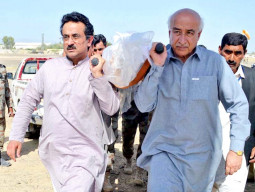
ISLAMABAD:
Since Pakistan put its revised anti-terror policy in place after the Peshawar school massacre, the country has witnessed a dramatic decline in violence in all provinces but one. Balochistan continues to bleed.
More than 112 people, both civilian and servicemen, have lost their lives since December 16, 2014 – a number larger than the collective figure from three other provinces, where 79 people have been killed during the same period, according to statistics gathered by The Express Tribune from provincial home departments.
Last year, 240 people were killed and 1,190 were injured in the province.
A study of the 100-day performance reports prepared by officials assigned to execute the 20-point agenda of the National Action Plan (NAP) suggests the federal government has failed to execute the major points of the much-trumpeted anti-terror plan in Balochistan to wipe out insurgency.
Balochistan Home Minister Sarfraz Bugti admits the province lags behind others in implementing the plan. “We could not take any solid action against separatists under the NAP. We need more force to wipe out insurgency from Balochistan,” he said. “While the government will always prefer dialogue [with armed militias], now is the time to choose between talks and a decisive operation.”

The troubled province has witnessed the highest number of violent incidents (29) since the announcement of the NAP on December 25. In the latest attack, insurgents gunned down 20 construction workers on April 11.
Pakistan has endured as many as 140 violent incidents during the period including three suicide bombings. The progress reports reveal that Punjab, Khyber-Pakhtunkhwa (K-P) and Sindh have witnessed between 30% and 60% decrease in violence. Last year, 7,660 people lost their lives in attacks throughout the country. In 2013, the count stood at 5,680.
Compared to Balochistan, the tribal areas – probably the most violent parts of Pakistan – saw 19 terror incidents during the same period with 79 fatalities. Another 37 people lost their lives in K-P, which saw nine terror attacks. Punjab witnessed five violent incidents with 34 casualties. Sindh went through eight such attacks in which 11 people were killed.
These figures, however, do not include the number of people killed in drone strikes and in gunfights with law enforcers. At least 33 militants were killed in drone attacks during this period while around 852 terrorists were killed in military operations.
K-P police chief Nasir Khan Durrani claims the overall number of terror-related incidents have gone down by around 60%. There has been only one suicide bombing as compared to five such attacks during the same period last year. Similarly, explosions through improvised explosive devices have gone down substantially.
Punjab Home Minister Lt (retd) Shuja Khanzada claims that violence has declined by 30% in the province. Listing the reasons, he said around 1,600 clerics had been arrested for delivering hate speeches, distribution of hate material and misusing loudspeakers.
The Sindh government, which is mainly focusing on Karachi, believes police are successfully keeping peace in the province, as only five terror incidents have occurred in the province in the past three months.
But security analysts termed the decline in violence only temporary, reasoning that as the military tightens its noose, the militants tend to go underground.
“Violence is no indicator of radicalism. When the situation gets tough, the militants tend to go underground but do not abandon their projects,” observed Dr Ayesha Siddiqa, the author of Military Inc. “Our issue is we get confused between Sindh and Punjab,” she said.
Published in The Express Tribune, April 14th, 2015.






















































COMMENTS
Comments are moderated and generally will be posted if they are on-topic and not abusive.
For more information, please see our Comments FAQ